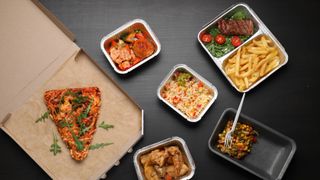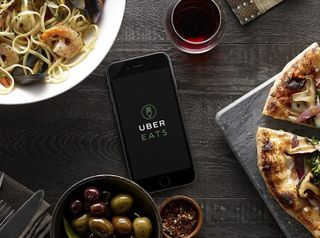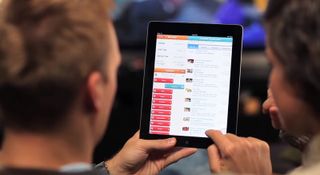Best food delivery service in the US: Uber Eats vs GrubHub vs DoorDash
There are almost too many delivery services and apps for order food. Here are the ones to go with and why.

The best food delivery service in the US is the one that gets you your food safely, on time, and at a cheap price matching in-restaurant menu prices.
There are three main takeout and delivery apps: Uber Eats, DoorDash, and GrubHub. The latter also owns smaller US delivery services Seamless and Eat24.
We've all used of these delivery services before for various reasons, including when we're sick at home, tied up with too much work, or painfully hungover. Nowadays there's a new reason to order delivery: we're shut-in due to coronavirus.
Because of the ongoing pandemic, some services have dropped delivery fees. It'll still cost you more than picking up the food yourself – tipping a delivery person is vital given the new threat to their livelihood – so picking the right service is important.
Here's what we have experienced when ordering delivery from Uber Eats, DoorDash, and GrubHub.

1. Uber Eats
Why you can trust TechRadar
Uber Eats is Uber's food-focused spinoff in which the 'passenger' is food and the destination is you. The convenient thing here is that while there's a separate app, your information can be seamlessly pulled over from the main Uber app.
New is the fact that Uber is pushing a $0 delivery fee for users who order from 'local' restaurants. This is its way of supporting independent restaurants during the COVID-19 outbreak. You'll still find Uber Eats charging $0.99 delivery fees for McDonald's and up to $2.99 other chains, though, and this new perk does make the Eats Pass ($0 delivery fees and 5% off orders over $15) for $9.99 a month less relevant.
There's an Uber Eats promo code valid for the remainder of March: NOLINENOFEE for $5 off your next two pickup orders, in case you venture outside and do your best to maintain the practice of social distancing.
Finally, for no-contact deliveries, you can add notes for your delivery person, so use something like "leave at the door" or "leave in lobby" to take extra precaution. Delivery notes do exist on other services, but Uber Eats is really pushing the idea, which means drivers will likely be more aware of the emphasis on zero contact.

2. GrubHub
GrubHub, like its subsidiaries Seamless and Eat24, is filled with local restaurants that offer takeout and delivery. While the company isn't waiving delivery fees for you, it it is delaying fees it collects from restaurants (they'll still owe the money later).
Its premium GrubHub+ is actually worth looking into and why it ranks 2nd in our best food delivery services list. It costs $9.99 a month for unlimited free delivery from 100,000 participating restaurants and 10% cashback on orders. That's a bit better than the 5% offered by the Uber Eats subscription service.
One last thing: GrubHub has a perks tab with various rewards designed for frequent customers. If you order from the soup-focused Hale and Hearty, for example, you'll get $5 for every $50 spent over time. This perk system appears to tie into another GrubHub subsidiary, mobile payment service LevelUp, which also offers freebies.

3. DoorDash
DoorDash is the small-start-up-turned-big-success story that is now worth more than GrubHub. Its UI is fairly friendly and the menus are easy to navigate, but the perks are more limited (read: non-existent) than the competition.
Like GrubHub, DoorDash is delaying the collection of fees from restaurants and it's offering 10% off on pick-up orders with the DoorDash promo code PICKUP10. But there's no big reason for users to choose this over Uber Eats, which is waiving fees on the users end, too.
There is one way to get out of delivery fees with this service: DashPass is the official subscription service for this app. It costs $9.99 a month and it offers $0 delivery fees on orders that cost $15 or more. No percentage off of your orders, though.

4. Seamless
Since they merged, Seamless operates essentially just like GrubHub - and after they aligned their technology years ago, they even look the same. But if you were wondering whether they differ, wonder no more: some regions (like New York, where Seamless was founded) just recognize one over the other.
Like GrubHub, Seamless isn’t waiving delivery fees, but it is temporarily postponing fees collected from partner restaurants. And Seamless has its own $9.99-per-month service called Seamless Plus that operates identically to GrubHub+, offering unlimited free delivery from the same pool of over 100,000 restaurants and offering 10% cash back on orders (but only after spending $100).
While GrubHub and Seamless have allegedly pursued questionable practices to funnel customers through its services without restaurant permission - see this Verge guide for ordering directly from restaurants, if you’re so inclined - the food delivery conglomerate has set up its own relief fund to help local businesses. To contribute to the Seamless Community Relief Fund, you can either opt to round up your order and contribute the spare change or donate outright, and the GrubHub parent company will match it.

5. Postmates
While Postmates is more of a deliver-anything kind of service, that includes restaurants. But its more limited availability - across all 50 states, but only in larger cities - makes it drop lower on our list. But if you are in the area, its flexibility and deals could save you money.
Order online or using the mobile app and you can browse deals among restaurants with variable delivery fee rates - as well as some chains that drop fees altogether when you enter codes. There’s also Postmates Party, a select group of tending restaurants that offer temporary free delivery while they’re trending among customers.
Like the others on this list, Postmates has launched its own Postmates Fleet Relief Fund, though this is reserved for defraying co-pays or coronavirus-related medical expenses for deliverers. Should they contract the virus, they can draw on the fund for two weeks of paid sick leave. Customers can also opt for non-contact deliveries to have their order left in the lobby or doorstep.
Grocery delivery, too!
Most of these services are dedicated to helping customers order directly from restaurants. But if you’re in the mood for more home-cooked fare, you can get your groceries sent to you, too, by a variety of services including Instacart, Fresh Direct, and more.
Check out our best online grocery delivery services page for all the services we recommend if you just want groceries and other supermarket goods brought right to your door.
- Check out out guides to picking a Samsung phone or one of the best Android phones
Get daily insight, inspiration and deals in your inbox
Get the hottest deals available in your inbox plus news, reviews, opinion, analysis and more from the TechRadar team.

